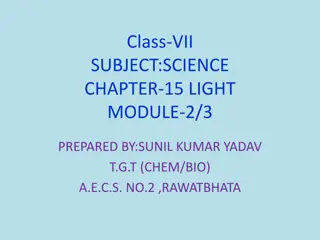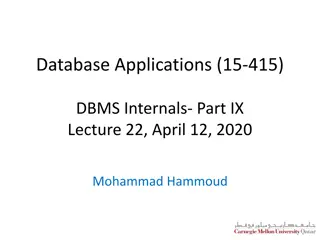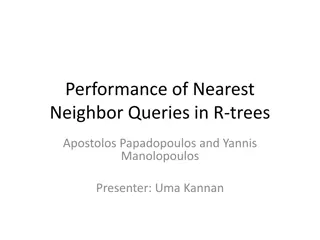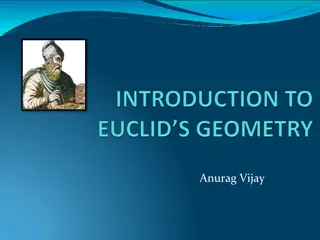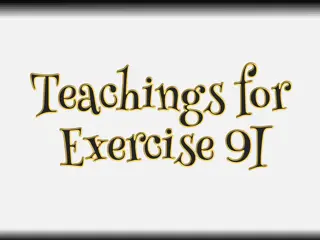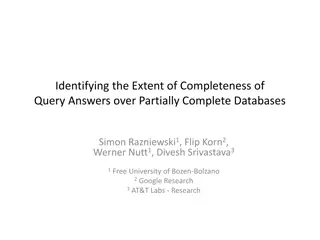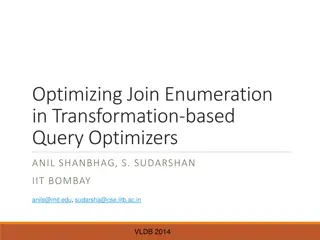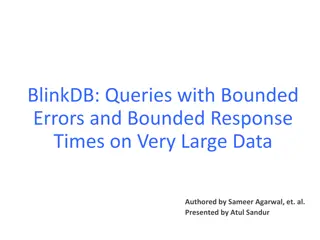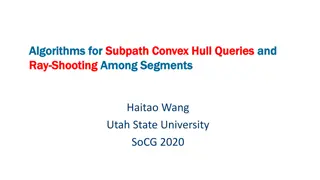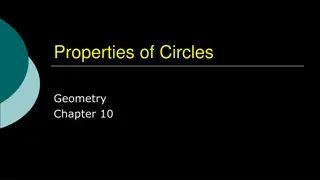Exploring Links Between Convex Geometry and Query Processing
Delve into the intersection of convex geometry and query processing at Stanford University, where theoretical discussions are being applied to real-world database engine development. Learn about the optimization of database joins, the historical evolution of database engines, and the challenges faced in achieving optimal efficiency in database operations.
Download Presentation

Please find below an Image/Link to download the presentation.
The content on the website is provided AS IS for your information and personal use only. It may not be sold, licensed, or shared on other websites without obtaining consent from the author. Download presentation by click this link. If you encounter any issues during the download, it is possible that the publisher has removed the file from their server.
E N D
Presentation Transcript
Links between Convex Geometry and Join Processing Christopher R Stanford University
Query processing is not rocket science When you flunk out of query processing, we make you go build rockets. Anonymous (J. Hamilton or D. DeWitt)
Warning: This is (mostly) a theorytalk but we (and others) are building database engines with these ideas.
Motivation: Joins! Databases are about three things: Efficiency, Efficiency, and Efficiency Beyond Worst-case Worst-case Parallel
Joins Since System R R(A,B), S(A,C), T(B,C) Join(R,S,T) = { (a,b,c) : (a,b) in R, (a,c) in S, (b,c) in T} Join(R,S,T) = Join(Join(R,S),T) System R searches through pairwise joins For 40+ years, major commercial database use System-R style optimizer.
Nugget: DBs have been asymptotically suboptimal for the last 4 decades 6
Example Queries Data: R(A,B), S(A,C), and T(B,C) Today: graph where edges colored R,S,T. R Nodes are data values. S v T Q1 = Join(R,S) triples of nodes on a path of length 2 that goes via R then S Q2 = Join(R,S,T) triples of nodes that form R-S-T triangles
Background: Triangles [Alon 80, Loomis-Whitney 49] Data: R(A,B), S(A,C), and T(B,C)) Let Qbe Join(R,S,T) = R-S-T triangles If R,S,T contain N tuples, how big can |Q| be? R covers B, S covers C R(A,B), S(A,C) |Join(R,S)| N2 T(B,C)) |Join(R,S,T)| N2 Correct asymptotic:|Q| in ( N3/2 ) Can we compute Q in time O(N3/2)? 8
Pairwise Joins are Suboptimal R(A,B), S(B,C),T(A,C) Data R=[N] x {1} S ={1} x [N] T = {1} x [N] |R|=|S|=|T|=N [N]={1, ,N} JOIN(R,S) = [N]x {1} x [N] |Join(R,S)| = N2 DB is toast! N N 1 Data in R and S Panic! A simple modification: any pairwise join plan takes (N2) 9
Heavy versus Light Relax! [Itai & Rodeh 78, Alon et. al 97] It s cute, let s see it. The heavy-light technique 10
Sketch: Heavy v. Light Nodes Goal: Time O(N3/2) ignoring log factors. Call a node heavy if it has more than N1/2 neighbors. Let H be set of heavy nodes. (case 1) If v in H, check whether each edge e in E forms a triangle with v. x v1 .. y v2 2 probes: each O(1) time. e v N Edges Case I: In total most 2 N|H| probes Since |H| 2N1/2 then total time O(N3/2) 11
Case 2. (case 2) If v not in H, for each pair of edges check. x v1 .. y v2 v N Edges Case II: Each light node explores d(v)2 where d(v) is the degree of node v. N d(v) 2N3/2 d(v)d(v) v V-H v V-H Union is linear, so we re done. 12
Fractional Hypergraph Covers Given a hypergraph H=(V,E) a fractional edge cover is x : E R such that x 0 and for each v in V we have e : v in e x(e) 1 x(R) + x(T) 1 // cover for A x(R) + x(S) 1 // cover for B x(S) + x(T) 1 // cover for C Ex: R(A,B),S(B,C),T(A,C). x(R,S,T)=(1,0,1) or x(R,S,T)=(0.5, 0.5, 0.5) We think of a query as hypergraph to cover. R S T 14
Size bounds [GM05, AGM08] Fix a query Q=(V,E). Let N be a tuple of |E| positive integers. Define S(Q, N) be the maximum size of Q subject to|Re| Ne Thm [Atserias, Grohe, Marx FOCS08]: Given any hypergraph cover x for (V,E) then S(Q,N) e in E |Re|x(e) Triangle: |R|=|S|=|T| N, x(R)=x(S)=x(T)=0.5 N1.5 15
One more example. R(A,B,C),S(A,B,D),T(A,C,D),U(B,C,D) R(A,B,C),S(A,B,D),T(A,C,D),U(B,C,D) x(R) = x(S) = x(T) = x(U) = 1/3 Output size is O(N4/3) Known since Loomis-Whitney (1940s Geometers!) 16
AGMs result. Atserias, Grohe, and Marx (AGM) allow one to write a linear program that tightly bounds the output size of any join query. Proof using Han/Shearer s lemma (non constructive) Open: Compute the output in upper bound time? We would call this worst-case optimal 17
Ngo, Porat, R, and Rudra (PODS 2012) 1st algorithm for joins with optimal worst-case runtime (experts: optimal data complexity) We show AGM s fractional cover inequality is equivalent to the Bollab s-Thomason inequality from geometry. Algorithmic Idea: LP is a guide to decide heavy v. light of previous example. 18
Implemented & described at ICDT14! Todd Veidhulzen. Leapfrog Triejoin: A Simple, Worst-Case Optimal Join Algorithm [ICDT14, Best Newcomer Award!] Tidbit: Faster on cyclic queries than other commercial DB optimizers without resorting to specialized graph processing! 19
Much simpler proofs! Even simpler than heavy vs. light! Atri Rudra Hung Ngo Skew strikes back: New Developments in the Theory of Join Algorithms. (SIGMOD Record 13 ) 20
(1) Heavy versus Light Faster Detection:Alon-Yuster-Zwick, one can check if a graph contains a 2k-length cycle in O(N2-1/k) using heavy vs. light argument. Systems: Heavy vs. light used in parallel database systems (e.g., Teradata). 22
(2) Map Reduce Joins: Afrati & Ullman EDBT 2010 Q1 = R(A,B),S(B,C),T(A,C) Q2 = R(A,B),S(B,C) Mappers send data to reducer via hash function. B A Goal: Given p reducers, minimize communication by picking how large each attribute s share is. Afrati & Ullman. Solve Constrained Mathematical Program. Lower bound portion uses Covers! Optimal: Recast as a (fractional) cover problem! [Koutris, Suciu, and Beame PODS14] 23
(3) Tighter Runtime Guarantees Measure: longest runtime in each strata (Traditional Worst-case) Databases with N tuples. Databases with N+1 tuples. Yannakakis s seminal algorithm has a stronger guarantee for acyclic queries. Output Size 0.5N 0.2N O( N + OUT ) Databases with N tuples. General: O(N + Nw* + OUT) where w* is the fractional hypertreewidth (NPRR+Y s+Treewidth) Databases with N+1 tuples. 24
Begs a question: What is the tightest guarantee that one can hope for? 25
Pathology of Worst-case Analysis for Joins Worst case: answer is huge Usually, the answer is smaller than the database not larger! Worst case: one reads the entire input. Rarely, if ever, does this happen on large databases Worst case: insensitive how data are stored. Data often stored in an index or sorted, and this changes landscape My not-so-secret goal: Join theory even closer to practice. 26
We all want to go beyond worst-case Tim Roughgarden (Stanford) has great notes on this. One of the1st beyond worst- case analysis was by a DB theoretician: Ron Fagin. Instance Optimality 27
Measuring complexity Databases with N tuples. Worst-case analysis (Traditional CS) Databases with N+1 tuples. Let T(A,D) be # of steps that algorithm A takes on database D Let W(A,N) = supD T(A,D) s.t. D has N tuples Measure W(A,N) growth with N, asymptotically. 28
Notions of complexity Databases with N tuples. Instance Optimality Databases with N+1 tuples. Let T(A,D) be # of steps that algorithm A takes on database D Algorithm Opt is instance optimal if there exists constant c such that T(Opt,D) c T(A,D) for A in a class of algorithms and any D. Essentially singleton boxes, much stronger 29
What do join algorithms do? Famous algorithms: Hash, Sort-merge, index-nested, block-nested loop, Grace, PRISM, double pipelined. Observation: Algorithms are generic. Do not depend on data values but may use data order & equality. E.g., use an index to skip many consecutive values. Call these comparison-based algorithms. 31
A Nugget: A little sorting changes the complexity landscape a lot. 32
Warm up: Intersection [Huang & Lin 1972] Given two sorted lists R and S of length N R[1] < < R[N] and S[1] < < S[N]. Suppose R[j] = 2j and S[j] = 2j+1 for j=1 N At position i, no idea what comes next. Ping-pong back and forth (N) time 33
Warm up: Intersection [Huang & Lin 1972] Given two sorted lists R and S of length N R[1] < < R[N] and S[1] < < S[N]. Suppose R[i] = i and S[i] = N/2 + i for i=1 N/2 Skip to R[N] in O(log N) time! 34
Message: Difference in the certification Certify each alternation R[N] < S[1] is enough running time is Log(N) v. N Same: Input and output size are the same! Different: Work to certifyoutput is empty 35
Goal: Algorithms that run in time proportional to the size of a smallest certificate. 36
Generalizing Certificates to Joins Assume: a global attribute order A1 An. All relations are stored consistently with this order ( we can remove this ) To define a certificate, need to describe: 1. How are data stored? (search trees), and 2. How are certificates encoded? (arguments) 37
Think of the data in a trie A relation R(A2,A4,A5) A2 A4 A5 R[3] 1 2 4 A2 1 2 7 1 3 5 R[1,2] R[2,1] 7 4 2 A4 10 4 1 Index A5 indicates the tuples order. R[1,2,1] R[3,1,1] R[1,1,2] 38
NB: search trees capture hash tables, B+trees, tries, up to a log N factor. Compare elements in this dictionary order 39
Any algorithm must certify its output An argument is a set of propositional statements of the following forms. 1. R[i] < S[j] Here i,j are tuples of indexes as illustrated in previous slide. 2. R[i] = S[j] 3. R[i] = R[j] Certificate is an argument, cert, such that any instance that satisfies cert has the same output (up to isomorphism). 40
Certificate Complexity Goal: run in time O( (|cert| + Z) log N) where cert denotes a smallest certificate, Z is the size of the output, and N is the size of the data. NB: Input Size under log O hides constants depending on Q. Runtimes of the above are essentially instance optimal for comparison based. Ron Fagin says log-instance optimal 41
Comments about Certificates 1. A comparison-based algorithm (all available join algorithms) takes at least |cert| steps. 2. N |cert| where N is the input size (strictly finer notion of complexity) 3. Certificates provide an instance-dependent measure of complexity. (conditioning) 42
Minesweeper Algorithm (MS) Removing the haystack to find the needles 43
Minesweeper: Key operation Deduce: no output tuple can be in an interval Consider: Q = R(A,B),S(A) ([- , 1],*) A 2 3 3 B 4 2 5 (=2,[- ,3]) (=3, [3,4] ) No output tuple has A = 3 and B in [3,4] Index for R in (A,B) order A 4 Big Conceptual Change: Find best way to rule out all tuples not to find tuples. Index for S 44
Picture the Output Space as a Grid B R(A,B),S(A) values A 2 3 3 B 4 2 5 A 4 ([- ,4], *) ([- , 1],*) (=2,[- ,4]) R(A,B) S(A) (=3, [3,4] ) Goal: Run proportional to smallest cover. A values 45
The algorithm Idea: Reuse information as much as possible. 1. Pick an uncovered point, t. 2. Find all possible ways to cover twith gaps . t 3. Insert gaps in to a data structure. Hard part: Data structure to find t, efficiently. Repeat until all points covered. 46
Nugget: The boundary for efficiency has changed from the worst case. 47
The Boundary View a query as a hypergraph. R(A,B),S(A,B,C),T(B,C,D) Want: Acyclic-like properties but closed under edge removal. acyclic does not have this property. Turns out, -acyclic [Fagin83] is the right notion 48
Certificate Dichotomy [PODS14] Theorem [NNRR14, Certificate Dichotomy] Given query Q (1)if Q is -acyclic, then there is some order of attributes such that MS takes O(|cert| + Z) on all instances. (1)Assuming the 3SUM conjecture, for any - cyclic query there is some family of instances where any algorithm runs in time ( |cert|4/3 + Z) 49 O hides log N factor
Further Results 1. No polynomial time bound in |cert| for - acyclic queries (Exponential time hypothesis) -acyclic is the worst-case boundary, this changes complexity landscape. 2. Q, treewidth w, MS runs in O(|cert|w+1+ Z) time 3. Fractional results for triangle, O(|cert|3/2+ Z). 50






